
Editor’s Note: This is a guest post from Joe Maiellano.
Gin is perhaps the most versatile of the distilled spirits. Sure, whisky is delicious. With a world full of smoky single malts and spicy ryes (not to mention bourbons, and the underrated yet very fine selection of Irish whiskies), who would need to stray? But gin has a wonderfully complex flavor profile that is unrivaled by any other spirit.
At its core, gin is a neutral spirit that has been flavored with juniper, and often a variety of herbs, spices, flowers, citrus, and other flavors. Lemon, orange, and lime, as well as coriander, cardamom, and allspice, are all common. Right from the get go, gin is gifted with an almost infinite range of possible flavors and profiles. Enjoy citrus? Rose and cucumber? Oak and malt? Rosemary and thyme? There’s a gin out there to match your taste. And, for the same reasons, there is a perfect gin for every cocktail, liqueur, and mixer.
Many great men through history have enjoyed gin: Winston Churchill, FDR, Ernest Hemingway, etc. Read on to discover what they already knew, and how to become a gin aficionado yourself.
How Gin is Made
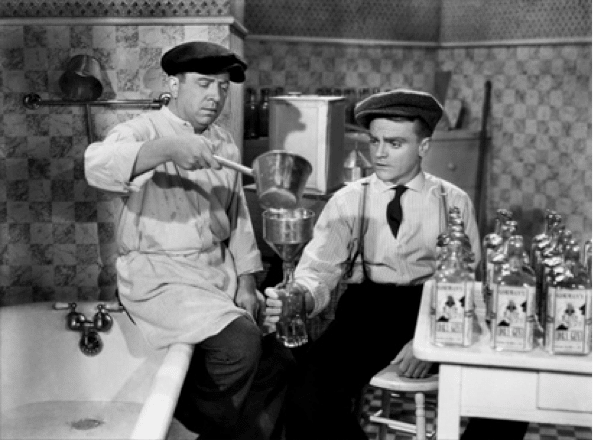
James Cagney making bathtub gin in The Roaring Twenties
The final flavor of gin, unlike most other spirits, relies less on the base spirit or the aging process than it does on the additions made by the distiller during production. Let’s take a stroll through the process of how gin is made:
1. Obtaining the neutral spirit.
Some distilleries will actually just source an already-distilled base spirit from another distillery. Others will use leftover base spirit from other liquors they make in-house. And still, others will go through the process of creating their own from scratch. As with other liquors, the basic process consists of:
- Creating a mash. Grain, water, and yeast are combined and heated, then allowed to ferment to create a low-alcohol “beer.”
- Distillation. The “beer” is strained, put into a still, and heated. Since alcohol has a lower boiling point than water, the alcohol will turn to vapor while the water and other byproducts are left behind, so long as the proper temperature range is maintained. The alcohol vapor condenses (either through coils in a pot-still or on plates in a column still), and is collected as the pure, neutral spirit.
2. Flavoring with botanicals.
Next, herbs, spices, citrus, flowers, and other flavorings are added to the neutral spirit to steep in a kind of boozy tea. All gin contains juniper berries (that’s what makes it gin, after all!), but the unique recipe of other botanicals is what makes each gin special. The time and technique vary – some distillers just dump everything in and strain it out later, others create mesh teabags, and still, others will actually hang the botanicals inside the still to allow just the vapor to pass through. No matter how they accomplish it, what the distillers are doing is allowing the alcohol to strip out the essential oils and retain the flavorings.
3. Final distillation.
Most commercial gins undergo a final distillation at this stage. They’re run through the still one more time, which allows the spirit to retain the flavor of the botanicals while getting rid of any color that it has taken on. Gins that skip this step, such as homemade gin, are referred to as “compound gins.”
The History of Gin
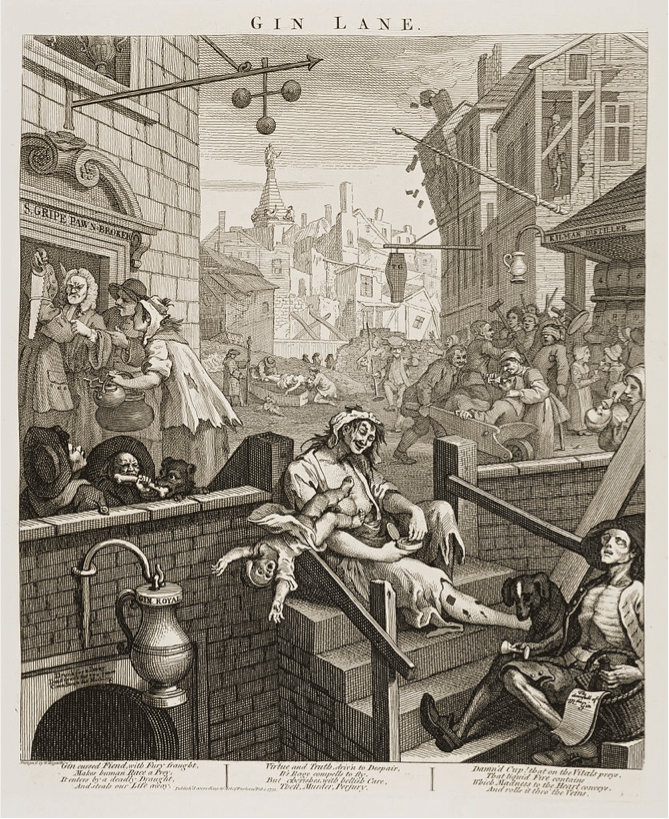
William Hogarth’s “Gin Lane”
Italian monks in the eleventh century produced an elixir of juniper berries steeped in alcohol to combat the Black Death (while not particularly effective, one would think that sipping a martini while dealing with the plague might have at least taken the edge off a little). The Dutch were distilling genever by the mid-1600s and shared it with their British comrades in the Eighty Years’ War (where it was known as “Dutch Courage”).
As happens with many battle-born food and drink proclivities, the British soldiers brought their taste for the Dutch gin back home with them, where it soon caught on like wildfire. The Dutch-born King of England, William of Orange, relaxed restrictions on home distilling, and increased tariffs on imported booze, leading to a meteoric rise in gin’s popularity. Low prices and widespread availability (fully more than half of the drinking establishments in 1730s London were “gin joints”), coupled with lax oversight, meant that London’s poor were in a perpetual stupor. William Hogarth famously captured the scene in his engraving, “Gin Lane.” The mid-1700s saw quality controls enacted, and the invention of the column still led to the refinement of the spirit into the gin with which we are familiar today.
Fast forward to Prohibition in America, and bootleggers found that the easiest spirit to emulate was gin. By steeping juniper, herbs, and spices in “alcohol” (whether actual moonshine, rubbing alcohol, medical alcohol, or even petroleum products) in a tub, bootleggers made bathtub gin. They often combined bootleg spirits with mixers (juice, soda, sugar) to cover up their horrendous flavor, and so was born the modern cocktail.
Men and Gin on the Silver Screen
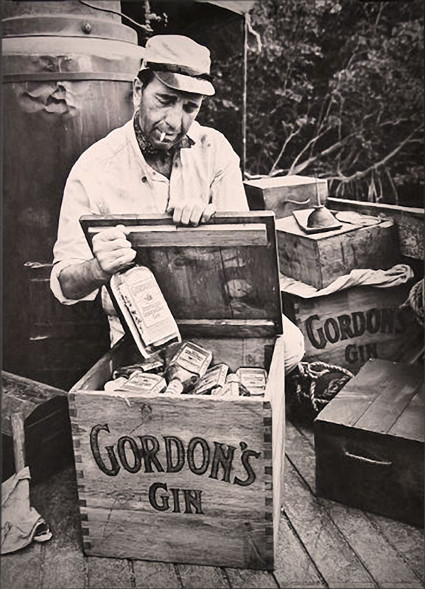
It’s said that everyone in the cast of The African Queen got dysentery except for Humphrey Bogart due to his copious consumption of gin.
There has long been a special place in popular culture for gin. There’s something about it that is gentlemanly and civilized, yet, a bit dangerous. It’s no wonder that some of the most iconic and manly characters ever to grace the silver screen or the pages of western literature have done so with a gin cocktail in hand.
There’s Cary Grant and Eva Marie Saint, engaged in a high-stakes game of seduction over a cooly-ordered Gibson in the dining car in North by Northwest.
There’s Bogie as the proprietor of Rick’s Cafe Americain in Casablanca – the most famous of “all the gin joints, in all the towns, in all the world.â€
Or Mad Men’s Roger Sterling ordering simply, “Gibson, up.â€
Before film and TV, gin had a starring role in the literature that shaped our culture. It was fitting that Fitzgerald’s anti-hero, Jay Gatsby, was a gin-slinger.
Hemingway wrote, in a case of art imitating life, some of the best prose ever conceived about gin – in A Farewell to Arms, Frederic Henry says, of drinking martinis, “I had never tasted anything so cool and clean. They made me feel civilized.â€

And of course, Ian Fleming’s iconic creation, James Bond and his Vesper martini.
Speaking of Martinis…
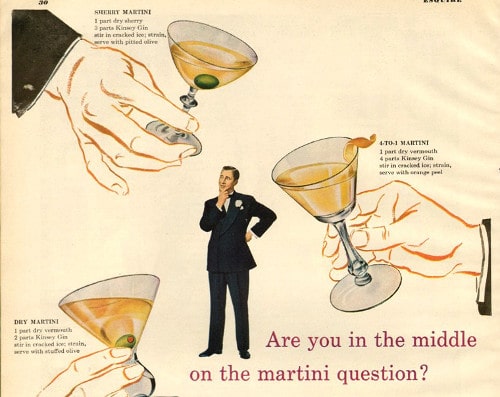
Martinis really are the quintessential gin drink. Heck, they’re the quintessential drink. Period. Their beauty is in their simplicity. H.L. Mencken called the martini “the only American invention as perfect as the sonnet.†But this almost Zen-like elixir still manages to stump many mixologists and imbibers alike. How much vermouth to use? Shaken or stirred? Olives or twist?
The simple answer is, there is no right answer – it’s all a matter of preference. Everyone has their own take, and I’ll humbly offer mine.
In Across the River and Into the Trees, Hemingway describes the Montgomery: a very dry martini that is 15 parts gin to one part vermouth. Old recipes dating back to the 1800s call for as much as equal parts gin and vermouth. If you use good vermouth such as Dolin or Lillet (not just the bottom-shelf stuff), you’ll want to taste it as a complement to the flavor of the gin. Personally, I like a ratio of 4 or 5 parts gin to 1 part of Dolin dry vermouth. Swap out the dry (white) vermouth for sweet (red) vermouth in the same amounts, and you have a Martinez.
To answer the big question – shaken or stirred? – we need to look at both physics and chemistry. Shaking a cocktail will make it colder, more quickly, than stirring. In addition, the added agitation will break up the ice into little shards that, with less surface area, melt quickly and dilute the drink. So, it depends on whether or not you prefer your martini ice cold and a little watered down (in which case, make like 007 and shake) or not as cold but a more pure product.
As to garnish: I’d argue that the proper garnish is dependent on the exact type of gin you are using. An olive is perfectly acceptable if you’re using a very dry gin, such as Gordon’s or Beefeater. In fact, Sinatra advised that you should always order two olives, so you’ll have one to share with a friend. However, if your martini is made with a particularly complex gin – say, Hendrick’s or Bombay Sapphire – you’re going to want to compliment some of the citrus and floral notes with a lemon twist. A cocktail onion generally follows the same rules as an olive, although then you’re not drinking a martini anymore, but rather a Gibson.
New Trends in Gin

While the martini may be the quintessential gin drink, gin is far from a one-trick pony. In fact, there are many exciting trends happening right now in the gin world. Take for example small-batch distilleries. Much like the micro-brewery movement of the 1980s and 1990s, America is seeing a surge in local micro-distilleries.
In the not-too-distant past, there were few options for the gin drinker. Your local bar would have Seagrams or maybe Beefeater, and that was all there was. Now, we live in a time and place where there are literally hundreds of different gins that all taste different, and that are accessible with a few strokes of your keyboard. Death’s Door in Wisconsin, Bluecoat in Philadelphia, Green Hat in DC… all are turning out world-class gins right in our backyards. It’s a great time to be a gin drinker!
Many of these local distilleries (and some of the big guys, too) have begun tinkering with seasonal and other limited-run batches. Green Hat has put out a winter blend that is distilled with caraway seeds (among other botanicals) in the style of aquavit.
Ransom out of Oregon has a barrel-aged gin that has a mellow amber color and pleasing oakiness that works amazingly well in a Martinez.
Even Plymouth, one of the oldest commercial gins going (since 1793!), has gone back to releasing its Navy Proof offering – bottled at a whopping 114 proof in order to last on long voyages. Come to think of it, if you like shaken martinis, that might just be the way to go…
Recipes
Once you’ve sampled enough gin, and found some favorites, give a few of these recipes a try:
Negroni
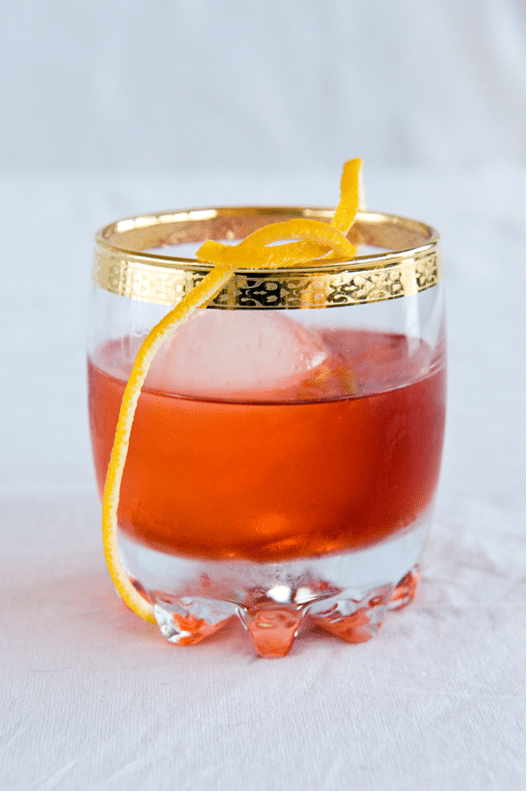
Italian Amari, such as Campari, is excellent at reviving one’s appetite and settling nausea after a night of over-indulgence. When married with the healthful qualities of gin, the coating properties of Italian-style vermouth, and the added protein from an egg white (which also lends a silky texture), we enjoy an elixir without equal for righting oneself – the Negroni.
- 1.5 oz gin
- 1.5 oz Campari
- 1.5 oz sweet vermouth
- 2 dashes orange bitters
- 1 egg white
- Orange twist
Combine gin, Campari, vermouth, bitters, and egg white in a cocktail shaker (no ice). Shake well for 30 seconds (this is called dry shaking; it helps integrate the egg white). Add ice to the shaker. Shake again for 30 seconds. Strain into an ice-filled rocks glass. Using a vegetable peeler or zester, cut a very thin strip of orange peel (avoid the white pith), squeeze the twist over the glass to release its oils, run the peel over the rim of the glass, and drop into drink.
French 75

This cocktail traces its roots to Harry’s Bar in Paris in 1915, where a WWI veteran wanted a little more kick in his glass of champagne. Legendary barman Harry MacElhone mixed this up for him, and the vet declared it packed a wallop like a French 75 (the Model 1897 75mm Howitzers he knew all too well from the war).
- 2 oz gin
- 1/2 oz simple syrup
- 1/2 oz lemon juice
- Champagne (or other dry sparkling wine)
- Lemon twist
In a shaker with ice, combine gin, syrup, and lemon; shake well. Strain into a chilled flute or coupe, and top up with champagne. Serve up with a strip of lemon zest as garnish.
Gin Rickey
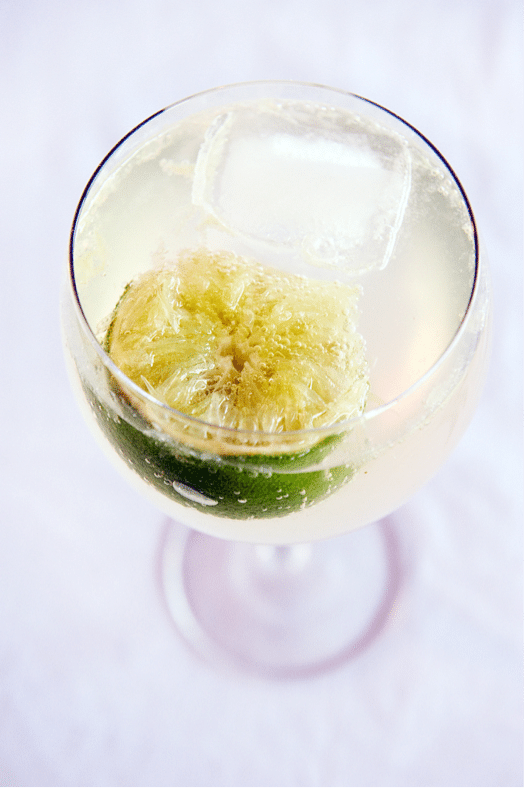
The Gin Rickey is Washington, D.C.’s native cocktail, invented by Col. Joe Rickey at a bar mere steps from the White House. Crisp and refreshing, it’s the perfect cocktail for the south’s swampy summers.
- 3 oz gin
- ½ fresh lime
- Sparkling mineral water (such as Apollinaris or Acqua Panna)
- 2 dashes orange bitters
Squeeze lime half into a rocks glass or large wine goblet and drop hull in as well. Fill glass with ice. Add gin, bitters, and mineral water. Stir to combine.
Shaken or stirred, traditional or small-batch, gin is the elixir of men and gods alike. Whether you’re a gin fan who might have discovered a new trend or a novice who was afraid to delve deeper, I hope you’ll join me now in raising a glass to this finest of spirits: gin.
______________________________
Joe Maiellano is co-founder of The HomeMade Gin Kit. He has been described as a spirit saith, alcohol enthusiast, and drunkard (though only the latter by his mother-in-law). He’s also been trying to single-handedly bring back the three-martini lunch.
Tags: Vices

